Related Research Articles
Andrew J. Looney is a game designer and computer programmer. He is also a photographer, a cartoonist, a video-blogger, and a marijuana-legalization advocate.
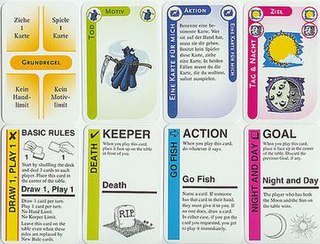
Fluxx is a card game, played with a specially designed deck published by Looney Labs. It is different from most other card games, in that the rules and the conditions for winning are altered throughout the game, via cards played by the players.
Looney Labs, Inc. is a small game company based in College Park, Maryland, United States. It is named after its founders, Andrew Looney and Kristin Looney, and is best known for creating the Fluxx line of card games. The company has three U.S. patents and eight Origins Awards.
Aquarius is a card game created by Andrew Looney and published by Looney Labs. The game play has some similarity to the game of dominoes. The card design and feel of the game is influenced by the Hippie movement and the art of Peter Max. The game has been released in two editions. The First Edition deck contained 5 Goal cards, 15 Action cards and 40 Element cards. The current Second Edition deck has 5 Goal cards, 18 Action cards, 55 Element cards and 1 "Wild" card.

Ticket to Ride is a series of turn-based strategy railway-themed Eurogames designed by Alan R. Moon, the first of which was released in 2004 by Days of Wonder. As of 2024, 18 million copies of the game have been sold worldwide and it has been translated into 33 languages. Days of Wonder has released digital versions of the board games in the series, as well as Ticket to Ride-themed card games and puzzles.
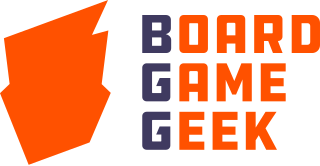
BoardGameGeek (BGG) is an online forum for board gaming hobbyists and a game database that holds reviews, images and videos for over 125,600 different tabletop games, including European-style board games, wargames, and card games. In addition to the game database, the site allows users to rate games on a 1–10 scale and publishes a ranked list of board games.

Agricola is a Euro-style board game created by Uwe Rosenberg. It is a worker placement game with a focus on resource management. In Agricola, players are farmers who sow, plow the fields, collect wood, build stables, buy animals, expand their farms and feed their families. After 14 rounds players calculate their score based on the size and prosperity of the household.

Pandemic is a cooperative board game designed by Matt Leacock and first published by Z-Man Games in the United States in 2008. Pandemic is based on the premise that four diseases have broken out in the world, each threatening to wipe out a region. The game accommodates two to four players, each playing one of seven possible roles: dispatcher, medic, scientist, researcher, operations expert, contingency planner, or quarantine specialist. Through the combined effort of all the players, the goal is to discover all four cures before any of several game-losing conditions are reached.

Enchanted Forest is a board game designed by Alex Randolph and Samuel Etchie in 1981, that requires players to remember the locations of fairytale treasures. The first edition of the game was published by Ravensburger in Germany in 1981 under the original name Sagaland.
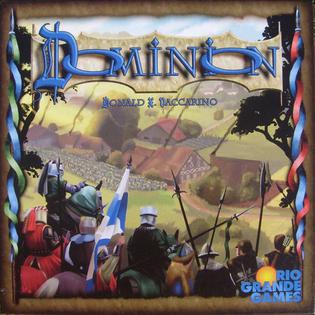
Dominion is a card game created by Donald X. Vaccarino and published by Rio Grande Games. Originally published in 2008, it was the first deck-building game, and inspired a genre of games building on its central mechanic.

Race for the Galaxy (RftG), or simply Race, is a card game designed by Thomas Lehmann. It was released in 2007 by Rio Grande Games. Its theme is to build galactic civilizations via game cards that represent worlds or technical and social developments. It accommodates two to four players by default although expansions allow for up to six players, as well as solo play. The game uses iconography in place of language in some places, with complex powers also having a text description. While appreciated by experienced players for being concise, some new players find the icons difficult to learn and to decipher.
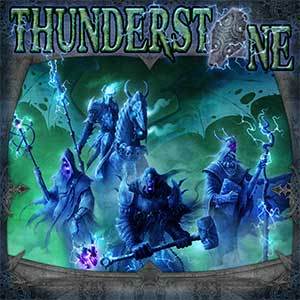
Thunderstone is a fantasy deck-building card game series designed by Mike Elliott, with artwork by Jason Engle. It was first published by Alderac Entertainment Group in 2009. Each card has dimensions of 6.3 cm x 8.8 cm. It has been translated into several languages.
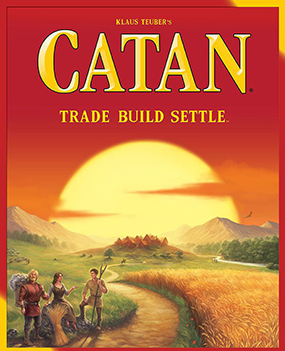
Catan, previously known as The Settlers of Catan or simply Settlers, is a multiplayer board game designed by Klaus Teuber. It was first published in 1995 in Germany by Franckh-Kosmos Verlag (Kosmos) as Die Siedler von Catan. Players take on the roles of settlers, each attempting to build and develop holdings while trading and acquiring resources. Players gain victory points as their settlements grow and the first to reach a set number of victory points, typically 10, wins. The game and its many expansions are also published by Catan Studio, Filosofia, GP, Inc., 999 Games, Κάισσα (Káissa), and Devir. Upon its release, The Settlers of Catan became one of the first Eurogames to achieve popularity outside Europe. As of 2020, more than 32 million copies in 40 languages had been sold.

Star Wars: X-Wing is a miniature war game designed by Jay Little and produced by Fantasy Flight Games that was released at Gen Con during August 17, 2012. It features tactical ship-to-ship dogfighting between various types of starfighters set in the fictional Star Wars universe. The game is said to be easy to learn and quick to play taking anywhere between 15 and 60 minutes from first set-up to battle's end. Each round both players give all their ships movement orders without knowing what their opponent is doing before resolving these orders while trying to shoot down enemy craft. On May 1, 2018, FFG announced X-Wing Second Edition, to be released on September 13, 2018. Although the physical models are transferable, an entire new set of rules, templates, and markers have been produced and are available through a new core set, waves, and conversion packs.
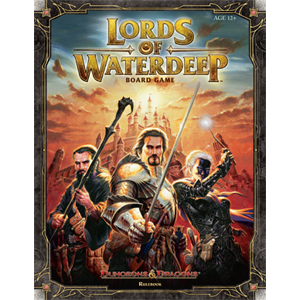
Lords of Waterdeep is a German-style board game designed by Peter Lee and Rodney Thompson and published by Wizards of the Coast in 2012. The game is set in Waterdeep, a fictional city in the Forgotten Realms campaign setting for the Dungeons & Dragons role-playing game. Players take the roles of the masked rulers of Waterdeep, deploying agents and hiring adventurers to complete quests and increase their influence over the city.

The Lord of the Rings: The Card Game is a card game produced by Fantasy Flight Games since 2011. As part of the Living Card Game (LCG) genre, it is a cooperative and strategic card game set in Middle-earth, a fantasy world featured in literary works by J. R. R. Tolkien, including The Hobbit and The Lord of the Rings.
Castle Panic is a board game designed by Justin De Witt and published by Fireside Games in 2009 Castle Panic is a tower defense strategy game in which players work cooperatively to protect a castle from monsters. The game was a nominee for the 2010 Golden Geek Best Family Board Game.
A Game of Thrones: The Card Game Second Edition is a Living Card Game (LCG) produced by Fantasy Flight Games from 2015 to 2020. It is based on A Song of Ice and Fire, a series of novels written by George R. R. Martin. The second edition of this LCG, it is not backwards compatible with the first edition that preceded it.

Colt Express is a railway-themed family board game designed by Christophe Raimbault, Illustrated by Ian Parovel and Jordi Valbuena, published in 2014 by Ludonaute and distributed by Asmodee.
Legendary: A Marvel Deck Building Game is a cooperative deck-building game for 1-5 players, released in 2012. It was designed by Devin Low and published by Upper Deck Entertainment, a division of Upper Deck Company.
References
- 1 2 3 4 5 6 Liu, Jonathan H. (January 5, 2010). "Chrononauts v. 1.4 Plus The Gore Years Expansion". GeekDad.com. Retrieved March 19, 2016.
- 1 2 3 4 5 6 7 West, Susan. "The Looney Labs Experiment". GAMES. October 2005. Retrieved June 16, 2015.
- 1 2 3 Jackson, Micah (July 7, 2001). "Origins Awards Announced: Pyramid Wins Best Magazine". Pyramid Magazine. Steve Jackson Games. Retrieved June 8, 2015.
- 1 2 3 4 "2011 Origins Award Winners". ICv2. June 27, 2011. Retrieved July 23, 2015.
- 1 2 3 "Parents' Choice Award-Winning Company: Looney Labs". Parents-Choice.org. Parents' Choice Foundation. Archived from the original on June 26, 2015. Retrieved June 24, 2015.
- 1 2 3 4 "History of Looney Labs". Looney Labs.com. Looney Labs. 16 September 2011. Retrieved July 22, 2015.
- 1 2 3 4 "Early American Chrononauts". 1001 Nights of Gaming. Spotlight on Games. Retrieved March 22, 2016.
- 1 2 3 4 Kidwell, Tim (October 1, 2010). "Back to the Future: The Card Game from Looney Labs". Model Retailer. Kalmbach Publishing Co. Archived from the original on March 11, 2016. Retrieved March 19, 2016.
- 1 2 "Back to the Future: The Card Game". ICv2. September 11, 2010. Retrieved July 23, 2015.
- ↑ Kaufeld, John (October 21, 2013). "2013 Alliance Open House features seminars, product reveals and more". Model Retailer. Kalmbach Publishing Co. Archived from the original on April 7, 2016. Retrieved March 25, 2016.
- ↑ "Chrononauts: The Rest of Row e Expansion".
- 1 2 "Chrononauts Card List". Looney Labs. 17 November 2011. Retrieved February 13, 2022.
- 1 2 3 4 Mastrangeli, Tony (July 30, 2013). "Chrononauts Review". Board Game Quest. Retrieved March 19, 2016.
- ↑ USpatent 6,474,650, Looney, Andrew J.,"Method of Simulation Time Travel in a Card Game",published 2002-11-05
- ↑ "Chrononauts". LooneyLabs.com. Looney Labs. 19 June 2011. Retrieved March 19, 2016.
- 1 2 Weier, Brad (January 12, 2005). "Review of Early American Chrononauts". RPGnet. Skotos Tech, Inc. Retrieved March 22, 2016.
- ↑ "ÜberChrononauts". wunderland.com. Looney Labs. Retrieved March 25, 2016.
- 1 2 3 Liu, Jonathan H. (October 1, 2010). "Looney Labs Takes Card Games Back to the Future". Geek Dad. Retrieved March 24, 2016.
- 1 2 "Chrononauts". Meoples Magazine. August 22, 2010. Retrieved March 22, 2016.
- ↑ "The Rest of Row E Product Announcement". Looney Labs. 2024-01-06. Retrieved 2024-03-30.
- ↑ Smith, Tim (May 17, 2019). "'Chrono-Trek' Into The Final Frontier". icv2.com. Retrieved April 21, 2020.
- ↑ Bunge, Nicole (February 14, 2019). "'Marvel' and 'Jumanji Fluxx' in the Works". ICv2. Retrieved April 21, 2020.
- ↑ "Chrononauts (2000)". boardgamegeek.com. BoardGameGeek, LLC. Retrieved July 23, 2021.
- ↑ "Early American Chrononauts (2004)". boardgamegeek.com. BoardGameGeek, LLC. Retrieved July 23, 2021.
- ↑ "Chrononauts: Lost Identities". boardgamegeek.com. BoardGameGeek, LLC. Retrieved July 23, 2021.
- ↑ "Chrononauts: The Gore Years". boardgamegeek.com. BoardGameGeek, LLC. Retrieved July 23, 2021.
- ↑ "Back to the Future: The Card Game (2010)". boardgamegeek.com. BoardGameGeek, LLC. Retrieved July 23, 2021.
- ↑ "Star Trek Chrono-Trek (2019)". boardgamegeek.com. BoardGameGeek, LLC. Retrieved July 23, 2021.
- ↑ "Chrononauts". boardgamegeek.com. BoardGameGeek, LLC. Retrieved March 22, 2016.
- ↑ Hite, Kenneth (February 18, 2001). "Live, From San Ramon, California: DunDraCon Report". Gamerati: Out of the Box. Archived from the original on April 2, 2016. Retrieved March 22, 2016.
- 1 2 "Chrononauts". 1001 Nights of Gaming. Spotlight on Games. Retrieved March 22, 2016.
- ↑ Clements, Brian Thomas. "Chrononauts: The Gore Years [Review]". Gamerati. Archived from the original on April 2, 2016. Retrieved March 22, 2016.
- ↑ "Early American Chrononauts". boardgamegeek.com. BoardGameGeek, LLC. Retrieved March 22, 2016.
- ↑ "Pyramid: Pyramid Review: Chrononauts (Beta Version)".